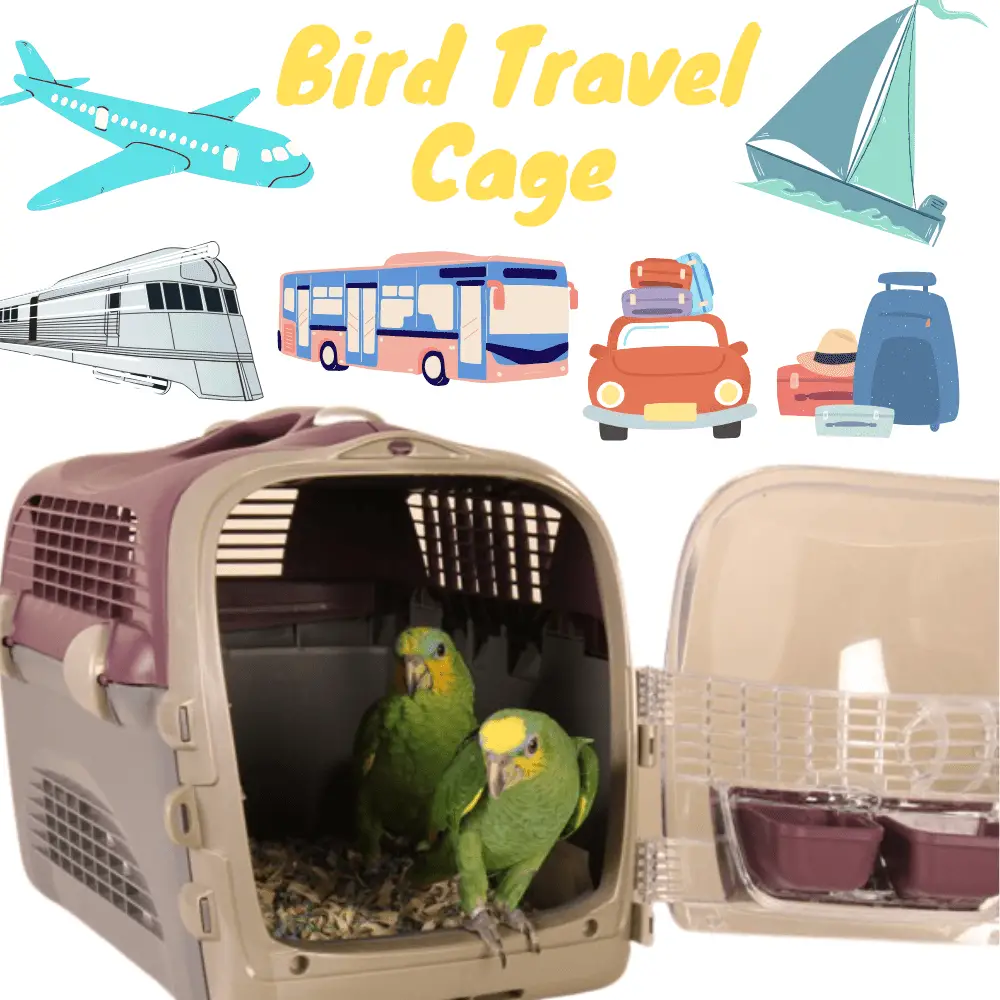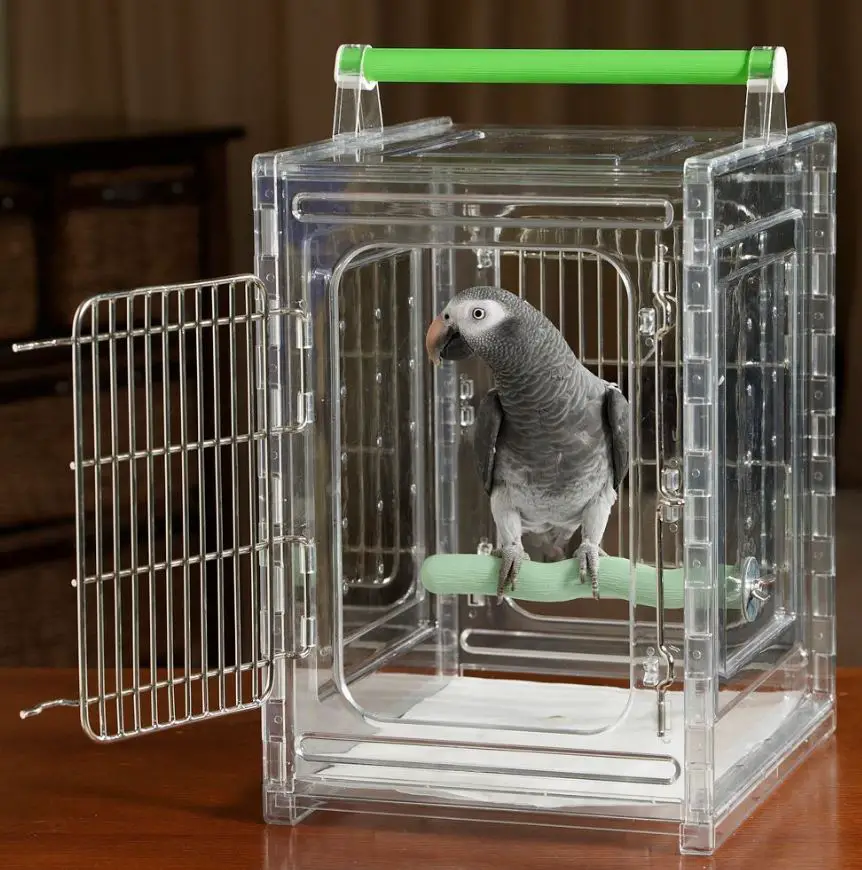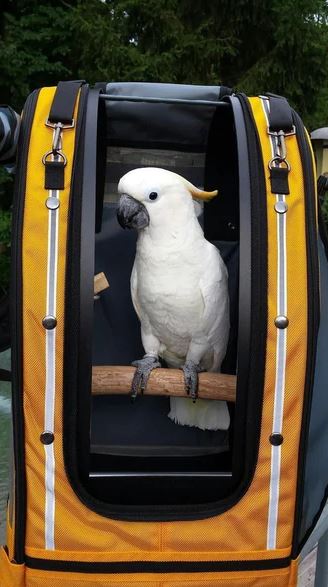
Bird Travel Cage is a basic accessory, but nevertheless essential when you decide to live with a parrot. It will be used to pick up your companion from its breeder, but also for veterinary appointments and for trips to daycare or on vacation.
It must be practical while being adapted to the size of your bird, the strength of its beak, and the use you will make of this cage. Don’t forget that you will wear it, so you have to make the right choice!
Parrot Transport Cage
Would you be prepared if you had to leave with your bird quickly, if you were in an emergency, or even just needed to take your bird to the vet?
These examples of travel can be stressful for birds that are unaccustomed to cage travel. It is therefore important that your cage is ready at a good time before any trip.
This way you have the time you need to prepare your bird and get him used to his new cage, without having to force him into an unfamiliar object.
 Bird Travel Cage
Bird Travel CageParrot Travel Cage Form
So here are some things to consider when buying your bird’s cage:
- The dimensions and type of cage you choose depend heavily on the species of bird you plan to purchase. Thus, large species will require a spacious cage that allows them to stand up and turn around easily.
- Passeriformes, especially finches and canaries, are transported safely in a plastic cage. However, bird species such as cockatoos with strongly pointed beaks can chew through almost any plastic. In this case, acrylic wire cages are preferable.
- Smaller species can fit through openings in a cage designed for larger birds. In addition, large cages cause stress in many small birds.
Practicality Bird Travel Cage
- Despite the size and shape of the carrier you buy, it should be easy to handle, transport, and install in the car.
- The cage should be made of sturdy material, but light enough for it to be transported without problems.
- A handle located on the top of the cage is practical; it makes it easy to attach the cage in the car by means of a seat belt. Also, it may be wise to have a shoulder strap in addition to the handle for heavy and large bird cages.
Hygiene
- The cage should be designed to open easily for cleaning. The fewer nooks, the better.
- Cages with a sliding tray are easy to clean, in addition to preventing the bird from escaping.
- A grid placed a few inches from the bottom of the cage is also a handy feature to separate your bird from the soiled substrate or paper liner.
Cage Substrate

Large bird travel cage
- A paper liner can be installed in the bottom of the cage to prevent your bird from slipping during transport, but this is not very hygienic. Indeed, feces soil the legs of birds.
- In order to reduce the damage of a substrate placed in the bottom of the cage and used to improve the hygiene of the same, it is preferable that the walls of the cage are solid and free of holes in its lower half.
- Phenol-free substrates are acceptable in cages with limited ventilation.
- Paper substrates are a great option.
Seed and water troughs
- Seed and water troughs should be easy to secure in the cage and accessible not only to the bird but also to the owner who must remove them for cleaning. Many cages are sold with the troughs included.
- Water bottles are handy in a carrier as they minimize spillage and help control the bird’s consumption.
It should be remembered, however, that not all birds are accustomed to drinking from a bottle. Thus, it is important to teach your bird how to use a water bottle to ensure that he drinks the proper amount of water while traveling. - If you are planning a long trip or if the weather is very hot, it may be necessary to add a water trough in addition to the water bottle to ensure your bird is hydrated.
Cage perches
- Some cages come with a perch and others are designed to allow you to add a perch of a particular design, size, and material to suit your bird’s needs (species, age, and size).
- Your bird will certainly feel safe if he has the opportunity to perch in the cage, especially if he is not used to traveling yet. In fact, some species will not poop if they are not perched at an adequate height.
- If you want to install a perch in the cage, place it so that the bird faces the windows when traveling, i.e. the ends of the perch are fixed forward and l rear of the vehicle. This way, the chicks are less likely to lose their balance and thus fall forwards and backward. Also, the surface of the perch should not be slippery in order to provide a secure and comfortable grip, like a rope perch. Such a perch folds easily to suit the size of the cage.
- The cage must always be installed in the car using a seat belt.
Night at a friend’s house
- If you want to spend the night or the weekend at a friend’s or friend’s house with your bird, it is best to use a cage that opens up and becomes an exercise center for your bird to perch on. above the cage.
Weather
- The ideal transport cages are designed in such a way as to provide optimal ventilation for the health of the bird, particularly if they are to be used in hot climates. A cage with a small number of openings for ventilation is suitable for cold climates to limit exposure to cold and drafts. However, you can still cover the cage with a warm blanket when it has multiple openings and it is cold.
- Cages made entirely of transparent plastic walls cause a lot of stress in birds that are not accustomed to traveling. In such a case, be sure to cover at least half of the cage to provide your bird with a safe area of protection.
- In hot weather, using a cage that is dark in color and made of thick materials is not recommended, but it may be necessary for cold temperatures.
Airline Approved Cages
Airlines have specific criteria for transporting animals. So, if you must travel by plane with your bird, you must choose a cage that is approved by the airline you are traveling with. Find out about the criteria specific to this company before you leave.
Once the transport cage has been purchased

travel bird cage for parrot
- You must write the bird’s name, your address, and your contact information on the cage so that all the information is visible and remains legible despite water and bites.
- Write down as much relevant information as possible so that the cage can be returned to you and that someone can take care of it in the event of an emergency evacuation where you are absent.
- Contact details for a family member or friend and your veterinarian or boarding center should also be listed.
Training session at the transport cage

Bird Travel Cage
- A transport crate is much more restrictive than a normal day crate.
- Objects to forage in the cage will make it inviting and not stressful.
- Positive reinforcement, such as play and visual and vocal praise, will help make this experience beneficial.
- It is important to allow your bird to enter and exit the cage at will during the initial desensitization sessions. However, when the bird is used to the cage and comfortable with it, it is important to ensure that it does not use it as a refuge. A cage considered a nesting cavity risks triggering the production of hormones and unwanted reproductive activities.
Training Parrot to Go in Travel Cage
SOURCE: Parrot Wizard
Storage
- Place the cage where everyone can easily access it in case of an emergency, such as a fire, hurricane, or an emergency visit to your veterinarian. Indeed, a cage stored in the outdoor cabin or in the attic will take far too long to collect.
- In addition, if the cage is stored in an outdoor hut, rodents may settle there and soil it. In such a situation, it is important to clean and disinfect the cage before using it; Rodent feces are dangerous to your bird.




















